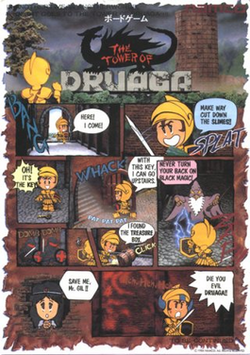The Tower of Druaga
| The Tower of Druaga | |
|---|---|

Japanese arcade flyer of The Tower of Druaga.
|
|
| Developer(s) | Namco |
| Publisher(s) | Namco |
| Designer(s) | Masanobu Endō |
| Programmer(s) | Satoshi Naito |
| Artist(s) | Yuichiro Shinozaki |
| Composer(s) | Junko Ozawa |
| Series | Babylonian Castle Saga |
| Platform(s) | Arcade, Family Computer, FM-7, Game Boy, MSX, PC Engine, X1, X68000, iOS |
| Release date(s) | |
| Genre(s) | Action RPG, Maze |
| Mode(s) | Up to 2 players, alternating turns |
| Cabinet | Upright, cabaret, and cocktail |
| Arcade system | Namco Super Pac-Man |
| CPU | 2x Motorola M6809 @ 1.536 MHz |
| Sound | 1x Namco WSG @ 1.536 MHz |
| Display | Vertical orientation, Raster, 224 x 288 resolution |
The Tower of Druaga (ドルアーガの塔 Doruāga no Tō?) is a maze-based action role-playing arcade game released by Namco in 1984. It is the first game in the Babylonian Castle Saga series, inspired by Sumerian and Babylonian mythology, including the Epic of Gilgamesh and Tower of Babel.
The game was a success, attracting millions of fans in Japan with its mix of action and role-playing game elements. The game laid the foundations for the action role-playing game genre, inspiring Nihon Falcom's Dragon Slayer. Both The Tower of Druaga and Dragon Slayer largely began the trend of combining RPG mechanics with arcade-style action mechanics, inspiring action role-playing games such as Hydlide and Ys as well as The Legend of Zelda.
The Tower of Druaga runs on Namco Super Pac-Man hardware but with a video system like that used in Mappy, and is the first game from Namco to display its year in Roman numerals on the title screen. It was later ported to the MSX, Famicom and remade for the PC Engine platform by Game Studio. Its first appearance outside Japan was in the third compilation of the Namco Museum Volume series for the PlayStation and also appears on Namco Museum compilations for Nintendo DS, PSP, and Xbox 360.
...
Wikipedia
